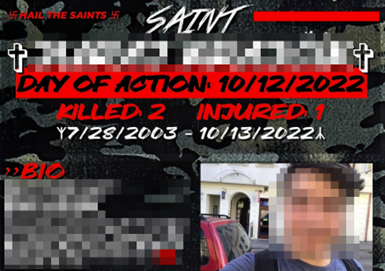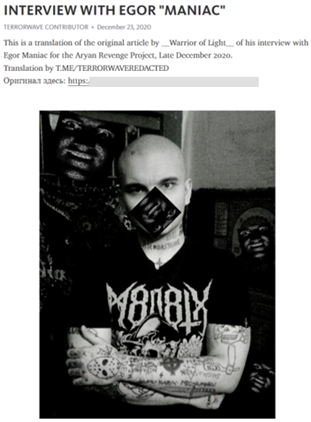Dismantling digital terror: Lessons learned from the collapse of Terrorgram
By Steven Rai
31 March 2025
In the late 2010s, the neo-Nazi accelerationist Terrorgram community emerged as a sprawling network of interlocking channels and group chats on Telegram. In addition to advocating for mass violence, key Terrorgram influencers successfully encouraged followers to conduct attacks in Slovakia and Brazil. While a series of arrests led to the effective dissolution of the network by late 2024, it continues to inspire violence worldwide. This Dispatch charts Terrorgram’s evolution and demise, drawing lessons to inform the responses of national security practitioners to online extremist ecosystems.
Key takeaways
From a national security perspective, examining Terrorgram’s rise and fall yields numerous insights that can inform practitioner responses to the shifting landscape of online extremism.
- Terrogram continues to inspire mass killers despite the takedown of senior leaders and online channels. Digital extremist networks are increasingly post-organizational, functioning as fluid transnational movements rather than isolated groups.
- Terrorgram’s transnational nature underscores the importance of international engagement and cooperation between national security practitioners. This is necessary to address the spread of harmful propaganda online and the potential for violence across borders.
- Continued law enforcement and platform pressure on neo-Nazi accelerationist networks is critical. These actors remain active and are attempting to re-emerge despite Terrorgram’s demise, highlighting the need for early intervention.
Background
In the late 2010s, Terrorgram emerged as a loosely connected network of hundreds of channels and group chats on Telegram which advocated for white supremacist violence and accelerationism. At its peak in 2019 to 2020, key content creators within the network leveraged their organizational capabilities and exploited Telegram’s ineffective moderation to coordinate the distribution of violent material across channels. These individuals were particularly adept at creating both propaganda and instructional materials, including slick artwork designed to incite violence, manuals for manufacturing firearms and explosives, and hit lists of potential targets.

Figure 1. An early example of ‘Saints Culture’ posted by a Terrorgram-affiliated channel in 2019. The image shows the ‘score’ (number of kills) of several white supremacist mass murderers. It also encourages others to make it onto the ‘leaderboard’ by perpetrating similar murders.
In early 2021, Telegram cracked down on the network as a result of increased public and government scrutiny on domestic extremism after the January 6 Capitol riot, as well as activist-led campaigns to report Terrorgram channels en masse. The platform banned dozens of channels, forcing key Terrorgram organizers to consider new strategies. This gave rise to the ‘Terrorgram Collective’, a more formalized group of senior figures within the ecosystem that aimed to maintain cohesion and strategic direction amid mounting external pressure. Terrorgram organizers shifted their focus from quantity to quality – instead of attempting to maintain a loose web of hundreds of interlocking channels, they centralized their efforts. They also prioritized longer-term projects including lengthy digital magazines and audiobook versions of terrorist manifestos.
In 2022, a Terrorgram leader was arrested and another became aware that he was under investigation. This created a leadership vacuum that was filled by two longstanding Terrorgram operators in the US. However, despite being skilled creators of digital propaganda, these new leaders lacked their predecessors’ organizational and strategic acumen, resulting in a significant loss of momentum. After a Terrorgram adherent attacked a gay bar in Slovakia in October 2022, the network failed to produce content that matched the influence of its previous works. The absence of strong leadership also allowed undisciplined influencers within the network to launch aggressive Telegram channels. These attracted a swift law enforcement response, leading to a series of arrests across the US that culminated in the effective collapse of the Collective in late 2024.
Successes and challenges in responding to Terrorgram
Law enforcement investigations
Years of investigations by national security agencies across North America and Europe shattered Terrorgram’s ability to operate as a cohesive organization. Law enforcement developed a strong understanding of the network’s activities, leading to regular arrests that stymied Terrorgram’s ability to produce propaganda and execute attacks. Authorities arrested key Terrorgram leaders and influencers in Slovakia, Canada and the US, as well as lower-level operatives who attempted to conduct violence.
These disruptions crippled both Terrorgram and the broader digital ecosystem of neo-Nazi accelerationists. ISD found that from August to November 2024, posts from such accounts declined by nearly 72 percent. While Terrorgram supporters continue to participate in online chat groups, they remain relatively unorganized and are attempting to migrate to new digital hubs which lack Telegram’s ease-of-use and functionality.

Figure 2. After a Terrorgram adherent conducted an attack in Slovakia in 2022, he was anointed a ‘Saint’ by others in the network.
Despite these victories, Terrorgram members fully entrenched in the ecosystem committed attacks in Slovakia and Brazil. The attackers were also in contact with some of the network’s most senior leaders, illustrating the challenge of coordinating law enforcement responses to internationally dispersed online networks and the ability of dangerous actors to slip through the cracks.
Pressure on Telegram
Since the arrest of Telegram CEO Pavel Durov in August 2024 by French authorities, the platform appears to have taken a stricter line on content moderation and legal compliance. Illicit channels are being banned more frequently, and many Telegram users believe it is no longer a secure venue for their operations.
Despite this progress, it is important to note that Terrorgram percolated relatively undisturbed on Telegram for years, allowing the network to flourish until its leaders were arrested. The platform enabled the network to disseminate violent propaganda, encourage sympathizers to conduct attacks and engage in operational planning. Moreover, Telegram’s moderation is still critically deficient: ISD analysis has found that it remains the most popular platform among violent extremists in the US.
Group proscription
The banning of Terrorgram as a terrorist entity occurred relatively late in the network’s lifespan. In early 2024, the UK became the first government to proscribe the network. Meanwhile, New Zealand authorities took a more content-focused approach, designating key Terrorgram publications as Objectional Material. In early 2025, the US and Australia followed suit with sanctions against the group. These measures echo similarly late efforts to ban neo-Nazi accelerationist groups, such as the proscription of Feuerkrieg Division in the UK in 2020, at which point the organization had been effectively defunct.
Although proscriptions against Terrorgram are likely to have been more impactful if they occurred when the network was at its peak, they nevertheless unlock a range of legal tools. These could help prevent the network’s re-emergence or limit the spread of its influential propaganda. Banning Terrorgram also creates legal avenues for prosecution, deters platforms from hosting Terrorgram materials and restricts the financial assets of its members.
On the other hand, the ambiguous nature of membership in Terrorgram complicates the enforcement of such terrorist designations; for example, the network lacks a formal recruitment process by which one becomes an official ‘member’, and it is unclear where engagement with Terrorgram material ends and membership in the Terrorgram Collective begins. Further, the possible migration of Terrorgram affiliates to non-compliant online platforms may limit the viability of certain sanctions.
A long-term legacy amid organizational collapse
While the Terrorgram Collective is effectively defunct, it continues to inspire a new generation of terrorist organizations as well as online communities that are obsessed with violence.
Terrorgram provided like-minded organizations across the globe with a platform to reach larger audiences. Terrorgram channels amplified the propaganda of neo-Nazi groups including Atomwaffen Division, The Base and Feuerkrieg Division, which had already gained traction across North America and western Europe. However, the network was also instrumental in exposing wider audiences to relatively obscure groups including the eastern European Maniac Murder Cult (MKY). In late 2020, Terrorgram’s flagship channel known as ‘Terrorwave Redacted’ published an English-language translation of an interview with MKY’s Ukrainian leader, likely among the first examples of the group being introduced to English audiences. MKY remains a persistent threat today: members have been linked to incidents including stabbings in Europe, a plot to poison children in New York City and hateful graffiti in Canada. Terrorgram’s role in fostering groups that continue to engage in violence illustrates its enduring legacy.

Figure 3. In late 2020, a major Terrorgram channel began publishing English-language translations of materials from the Maniac Murder Cult (MKY).
Beyond nurturing emerging neo-Nazi accelerationist groups, Terrorgram has also indirectly inspired more ideologically mixed communities to commit violence. The ‘Saints Culture’ promoted by Terrorgram has resonated with subcultures motivated by a complex blend of nihilism, misanthropy, and an obsession with violence and cruelty. In December 2024 and January 2025, teenagers involved in these subcultures carried out school shootings in the US. Both attackers left manifestos that highlighted Terrorgram publications or past Terrorgram-affiliated attackers as having inspired them. However, their motivations appear significantly more complex than previous white supremacist attackers. Despite both espousing racist views and one explicitly identifying as an accelerationist, the perpetrators cited numerous other ideological and aesthetic sources of inspiration for their violence. It is also unclear whether their attacks were intended to provoke long-term political change.
Lessons Learned: Implications for National Security Policy and Practice
The Efficacy of Nullifying Key Leaders and Influencers
One of the main takeaways from Terrorgram’s rise and fall is the effectiveness of arresting leaders and influencers in undermining extremist networks that primarily operate online. Unlike more formalised terrorist organizations such as the so-called Islamic State (IS) which were able to demonstrate greater resilience to shocks, the Terrorgram Collective was highly dependent on key charismatic figures with sufficient leadership skills to execute their strategic vision. Targeting these figures significantly weakened the network’s cohesion and output, ultimately leading to its collapse.
The Need for Early Intervention
Arrests played a central role in dismantling Terrorgram. However, its persistence highlights the challenges law enforcement faces in tackling decentralized extremist networks online. National security agencies face multiple legal, technological and institutional hurdles that can complicate investigations. Further, striking the right balance between collecting intelligence and disrupting threats is challenging. For example, the arrest of certain individuals can limit law enforcement’s visibility into their broader network and hamper their ability to gather evidence against others who may be involved.
There are a variety of options to stem the networks behind the online spread of harmful propaganda beyond simply arresting those involved. These include engaging with platforms or undertaking coordinated takedown campaigns. An initiative launched in 2019 by Europol against IS’ digital networks serves as an instructive example: by coordinating the referral of illicit accounts to several online platforms, they were able to achieve sweeping bans.
It is also important for national security practitioners to consider the post-organizational dimension of many online extremist networks. These networks function as fluid transnational movements rather than isolated groups, opening certain possibilities for law enforcement. For example, the emergence of MKY in Terrorgram spaces in 2020 may have created a window of opportunity to conduct early interventions against the group before it fully matured.
International Cooperation
International collaboration between law enforcement agencies is vital to address the threat posed by diffuse extremist networks such as Terrorgram. Digital propaganda demands a cohesive international response as it can influence radical actors and attract new adherents across borders. Terrorgram operators have been active across North and South America, Europe, Asia, and Africa, including in countries where English is not the primary language. The extent to which each of these affected countries understood the strategic threat posed by Terrorgram is unclear; it is equally unclear whether they had visibility into their citizens who went on to conduct attacks. International engagement therefore needs to occur early and often, and national security agencies must be proactive in exchanging information with their international counterparts.
The Ambiguous Role of Terrorist Designations for Online Networks
The effectiveness of relying on the formal designation of certain groups as terrorist entities and sanctioning their activities remains unclear in the context of loosely organized online networks like Terrorgram, with many arrests occurring without such designations. Additionally, it is important to note that the banning of the Terrorgram Collective in the UK, US and Australia happened long after the group’s power had peaked. While proscriptions may unlock valuable tools for national security agencies to impede the spread of propaganda or tackle a re-emergence of Terrorgram, they should not be viewed as a panacea to online extremist networks.
Conclusion
While the collapse of the Terrorgram Collective is a significant victory, its ideology and output continue to inspire violence worldwide. Even with the loss of key leaders, the broader neo-Nazi accelerationist community remains active, and recent assassination plots and recruitment efforts have been linked to this ideology and actors within it.
It is vital that national security practitioners maintain pressure on these groups, as the disruption of their leadership and digital operations is critical in preventing further violence. In addition to investigating and arresting leaders, early intervention and engagement with platforms and international counterparts are essential to combatting the evolving landscape of online extremism.



